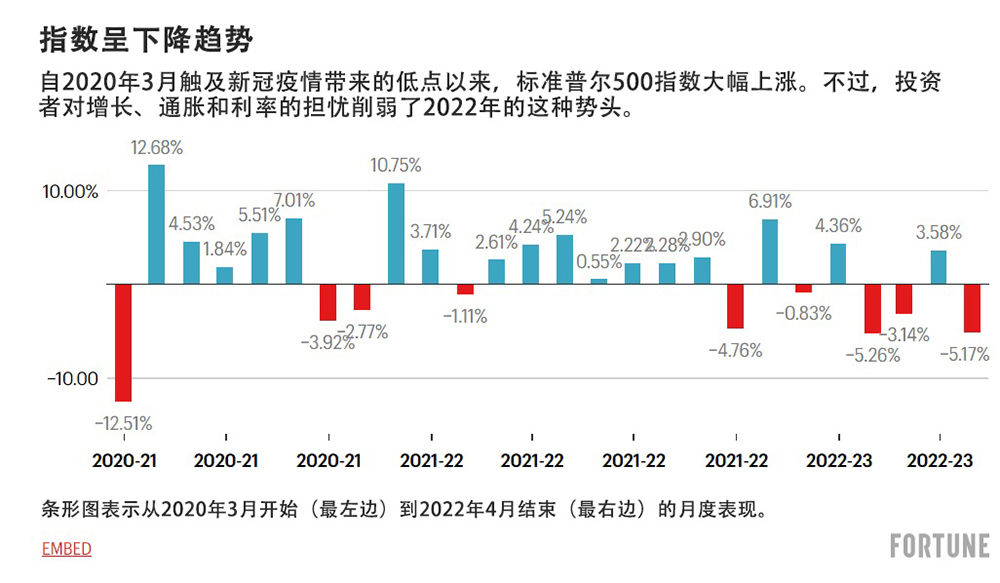在4月25日下午的尾盤交易中,,在科技股的帶動(dòng)下,,標(biāo)準(zhǔn)普爾500指數(shù)(S&P 500)有所回彈,總算是在連續(xù)四天的敗退后稍稍穩(wěn)住陣腳,。很多美股投資者都在猜測(cè)這是否是股市回暖的信號(hào),,但華爾街卻認(rèn)為,大家最好還是別指望它,。
盡管4月25日有所提振,,但表現(xiàn)卻相當(dāng)分裂。早盤基準(zhǔn)指數(shù)一度下跌了1.7%,,直到臨近午飯時(shí)間才有買家入場(chǎng),。但到全天塵埃落定,標(biāo)準(zhǔn)普爾500指數(shù)收漲24.34點(diǎn),漲幅為0.6%,。需要說明的是,,甚至在推特(Twitter)的董事會(huì)確認(rèn)將把公司出售給世界首富埃隆·馬斯克之前,這股漲勢(shì)就已經(jīng)開始了,。
從今年4月初到現(xiàn)在,,標(biāo)準(zhǔn)普爾指數(shù)(S&P)已經(jīng)跌了5.17%,僅以跌幅算,,已經(jīng)逼近2020年3月美國(guó)新冠疫情爆發(fā)以來的單月最差成績(jī),。
德意志銀行(Deutsche Bank)的研究策略師吉姆·里德在4月26日上午的一份投資者報(bào)告中寫道:“如果標(biāo)準(zhǔn)普爾指數(shù)跌破今年1月-5.26%的紀(jì)錄,那它就將成為新冠疫情以來美股跌得最慘的一個(gè)月,,而且這種風(fēng)險(xiǎn)仍然是存在的,。”

截至4月25日收盤,,標(biāo)準(zhǔn)普爾指數(shù)已經(jīng)較今年年初下跌10%,,逼近調(diào)整區(qū)間。納斯達(dá)克指數(shù)(Nasdaq)跌得更慘,,科技板“四大牛股”Facebook,、蘋果(Apple)、Netflix,、谷歌(合稱FANG)光上周一周就跌了9%,。
到目前為止,雖然各大上市公司一季度財(cái)報(bào)的數(shù)字都十分亮眼,,但華爾街普遍認(rèn)為當(dāng)前的股市尚未見底,。
比如,摩根士丹利財(cái)富管理公司(Morgan Stanley Wealth Management)的首席投資官麗莎·謝利特認(rèn)為,,股民的苦日子還在前頭,。“投資者可能認(rèn)為通脹即將見頂,,目前美國(guó)企業(yè)收益增長(zhǎng)強(qiáng)勁,,而且目前沒有更好的投資工具能夠替代美國(guó)證券市場(chǎng)。但是在我們看來,,熊市還沒有結(jié)束,。”
謝利特的熊市預(yù)期可以說代表了摩根士丹利的悲觀態(tài)度,。在4月25日的另一份報(bào)告中,,摩根士丹利的策略師們也使用了幾乎同樣的語言,指出標(biāo)準(zhǔn)普爾指數(shù)還將進(jìn)一步下跌,。邁克爾·威爾遜帶領(lǐng)的證券策略團(tuán)隊(duì)指出:“標(biāo)準(zhǔn)普爾500指數(shù)似乎已經(jīng)做好了進(jìn)入熊市的準(zhǔn)備,?!?/p>
期貨市場(chǎng)同樣面臨壓力
截至4月26日,,美國(guó)的期貨市場(chǎng)仍然面臨較大壓力,。截至美東時(shí)間上午5點(diǎn),標(biāo)準(zhǔn)普爾期貨指數(shù)下跌0.3%,。此外還有兩個(gè)投資者的看跌信號(hào)——作為“避險(xiǎn)港”的美元和黃金期貨都在升值,。
而在大西洋彼岸,歐洲股市在經(jīng)歷了4月25日的大跌之后大多開始走高,。而亞洲股市的表現(xiàn)則參差不齊,,上證綜指不出意料地繼續(xù)“跌跌不休”。
華爾街也在尋找任何看跌情緒即將轉(zhuǎn)變的跡象,?;鸬膭?dòng)向一直是一個(gè)被密切關(guān)注的指標(biāo),不過目前看來,,機(jī)構(gòu)們?nèi)匀挥X得形勢(shì)尚未好轉(zhuǎn),。
高盛集團(tuán)指出,上周,,全球證券市場(chǎng)資金凈流入為負(fù),,這標(biāo)志著全球股市已經(jīng)連續(xù)兩周出現(xiàn)資金出逃。這期間,,股市資金的出逃規(guī)模達(dá)到300億美元,,這也是自2020年第一季度以來最大規(guī)模的資金出逃事件。(財(cái)富中文網(wǎng))
譯者:樸成奎
在4月25日下午的尾盤交易中,,在科技股的帶動(dòng)下,,標(biāo)準(zhǔn)普爾500指數(shù)(S&P 500)有所回彈,總算是在連續(xù)四天的敗退后稍稍穩(wěn)住陣腳,。很多美股投資者都在猜測(cè)這是否是股市回暖的信號(hào),,但華爾街卻認(rèn)為,大家最好還是別指望它,。
盡管4月25日有所提振,,但表現(xiàn)卻相當(dāng)分裂。早盤基準(zhǔn)指數(shù)一度下跌了1.7%,,直到臨近午飯時(shí)間才有買家入場(chǎng),。但到全天塵埃落定,標(biāo)準(zhǔn)普爾500指數(shù)收漲24.34點(diǎn),,漲幅為0.6%,。需要說明的是,甚至在推特(Twitter)的董事會(huì)確認(rèn)將把公司出售給世界首富埃隆·馬斯克之前,,這股漲勢(shì)就已經(jīng)開始了,。
從今年4月初到現(xiàn)在,標(biāo)準(zhǔn)普爾指數(shù)(S&P)已經(jīng)跌了5.17%,僅以跌幅算,,已經(jīng)逼近2020年3月美國(guó)新冠疫情爆發(fā)以來的單月最差成績(jī),。
德意志銀行(Deutsche Bank)的研究策略師吉姆·里德在4月26日上午的一份投資者報(bào)告中寫道:“如果標(biāo)準(zhǔn)普爾指數(shù)跌破今年1月-5.26%的紀(jì)錄,那它就將成為新冠疫情以來美股跌得最慘的一個(gè)月,,而且這種風(fēng)險(xiǎn)仍然是存在的,。”
截至4月25日收盤,,標(biāo)準(zhǔn)普爾指數(shù)已經(jīng)較今年年初下跌10%,,逼近調(diào)整區(qū)間。納斯達(dá)克指數(shù)(Nasdaq)跌得更慘,,科技板“四大牛股”Facebook,、蘋果(Apple)、Netflix,、谷歌(合稱FANG)光上周一周就跌了9%,。
到目前為止,雖然各大上市公司一季度財(cái)報(bào)的數(shù)字都十分亮眼,,但華爾街普遍認(rèn)為當(dāng)前的股市尚未見底,。
比如,摩根士丹利財(cái)富管理公司(Morgan Stanley Wealth Management)的首席投資官麗莎·謝利特認(rèn)為,,股民的苦日子還在前頭,。“投資者可能認(rèn)為通脹即將見頂,,目前美國(guó)企業(yè)收益增長(zhǎng)強(qiáng)勁,,而且目前沒有更好的投資工具能夠替代美國(guó)證券市場(chǎng)。但是在我們看來,,熊市還沒有結(jié)束,。”
謝利特的熊市預(yù)期可以說代表了摩根士丹利的悲觀態(tài)度,。在4月25日的另一份報(bào)告中,,摩根士丹利的策略師們也使用了幾乎同樣的語言,指出標(biāo)準(zhǔn)普爾指數(shù)還將進(jìn)一步下跌,。邁克爾·威爾遜帶領(lǐng)的證券策略團(tuán)隊(duì)指出:“標(biāo)準(zhǔn)普爾500指數(shù)似乎已經(jīng)做好了進(jìn)入熊市的準(zhǔn)備,。”
期貨市場(chǎng)同樣面臨壓力
截至4月26日,,美國(guó)的期貨市場(chǎng)仍然面臨較大壓力,。截至美東時(shí)間上午5點(diǎn),標(biāo)準(zhǔn)普爾期貨指數(shù)下跌0.3%,。此外還有兩個(gè)投資者的看跌信號(hào)——作為“避險(xiǎn)港”的美元和黃金期貨都在升值,。
而在大西洋彼岸,歐洲股市在經(jīng)歷了4月25日的大跌之后大多開始走高,。而亞洲股市的表現(xiàn)則參差不齊,,上證綜指不出意料地繼續(xù)“跌跌不休”,。
華爾街也在尋找任何看跌情緒即將轉(zhuǎn)變的跡象?;鸬膭?dòng)向一直是一個(gè)被密切關(guān)注的指標(biāo),,不過目前看來,機(jī)構(gòu)們?nèi)匀挥X得形勢(shì)尚未好轉(zhuǎn),。
高盛集團(tuán)指出,,上周,全球證券市場(chǎng)資金凈流入為負(fù),,這標(biāo)志著全球股市已經(jīng)連續(xù)兩周出現(xiàn)資金出逃,。這期間,,股市資金的出逃規(guī)模達(dá)到300億美元,,這也是自2020年第一季度以來最大規(guī)模的資金出逃事件,。(財(cái)富中文網(wǎng))
譯者:樸成奎
April 25's late-afternoon tech-led rebound pushed the S&P 500 into the green, enough to break a four-day losing streak. Could it be a sign of things to come? Don't count on it, Wall Street says.
Even with April 25's uplifting performance for equities, there were plenty of Jekyll and Hyde moments. At its worst, the benchmark was down 1.7% midmorning, only for the buyers to show up around lunchtime. When the dust settled, the S&P closed up by 24.34 points, or 0.6%. Incidentally, the rally started even before the board of Twitter confirmed it had agreed to sell the social media platform to the world's richest man, Elon Musk.
Even with yesterday's positive showing, the S&P is down 5.17% in April, dangerously close to posting its worst monthly performance since March 2020—i.e., the nadir of the COVID collapse in equities.
As Deutsche Bank research strategist Jim Reid wrote in an investor note this morning, the S&P is “still at risk of taking the ignominious title of worst monthly return since COVID if it dips below this January’s -5.26% return.”
As of April 25's close, the S&P was hovering around correction territory year to date, or down 10%. The Nasdaq has fared even worse, with once high-flying FANG stocks sinking nearly 9% last week alone.
So far, few on Wall Street are ready to call a bottom even as corporate earnings season continues to generate a surprisingly strong number of bottom-line beats.
Lisa Shalett, chief investment officer of Morgan Stanley Wealth Management, was the latest one to warn investors of more pain ahead. "Investors seem to be banking on peaking inflation, strong earnings growth, and that there is no good alternative to U.S. equities. In our view, the bear market is not over," she said.
Shalett's bearish call underscores deeper pessimism at Morgan Stanley. In a separate note on April 25, strategists at the investment bank used almost identical language to say the S&P has further to fall. “The S&P 500 appears ready to join the ongoing bear market,” wrote the equities strategy team led by Michael J. Wilson.
Futures under pressure
On April 26, U.S. futures remained under pressure. At 5 a.m. ET, S&P futures were down 0.3%, off earlier modest gains. A further signal of investor bearishness: the safe-haven dollar was gaining, as were gold futures.
Across the Atlantic, the European bourses were mostly higher, after a rough April 25 selloff. Asian stocks were mixed, with Shanghai Composite again deep in the red.
Wall Street is looking for any indication the bearish mood will shift. One indicator, closely watched fund flow data, shows zero relief.
According to Goldman Sachs, net flows into global equity funds were negative last week for a second consecutive week. Over that span, investors pulled $30 billion out of equity funds, the largest pullout since the first quarter of 2020—again, when COVID jitters were clobbering the markets.






